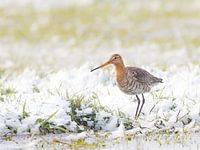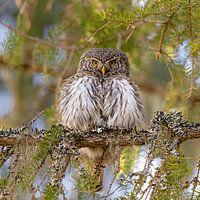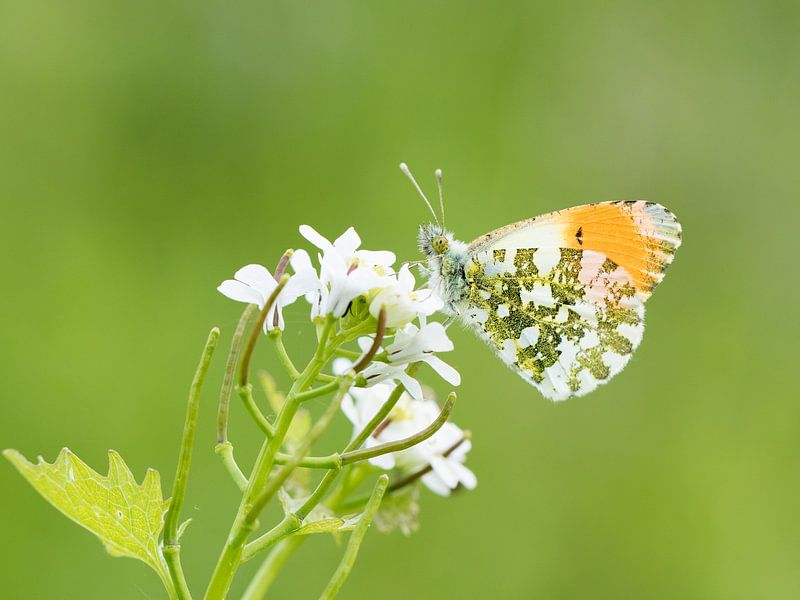Buy this landscape artwork Orange tip (Anthocharis cardamines) in Alblasserwaard by Jacob Molenaar on canvas, ArtFrame, poster and wallpaper, printed on demand in high quality.
About "Orange tip (Anthocharis cardamines) in Alblasserwaard"
by Jacob Molenaar
About the artwork
The orange tip, scientifically known as Anthocharis cardamines, is a conspicuous butterfly species belonging to the family Pieridae, the whites. This butterfly is native to Europe, including parts of Asia and North Africa, and is mainly found in temperate climate zones.
What distinguishes the orange tip orange butterfly is the distinctive orange wing tips in males, while females usually have a more marked green pattern. The underside of the wings is often marked green, providing excellent camouflage when the butterfly sits on leaves or flowers.
The orangetip's life cycle begins with the eggs being laid by females on the buds of various cruciferous plants, such as cinqueflowers and garlic-willow. After a few weeks, the eggs hatch and the caterpillars appear, feeding on the leaves of their host plants.
As the caterpillars grow, they undergo several molts before finally pupating. The pupae can be greenish or brown in colour, making them well camouflaged against predators and other threats.
Once the pupae are fully developed, the adult butterflies emerge. The orange tip is one of the first butterflies to appear in spring, usually in March or April, depending on the location. They are often attracted to flowering plants and live off nectar as a food source.
The orange tip plays an important role in the ecosystem as a pollinator of various flowers and a food source for predators such as birds and spiders.

About Jacob Molenaar
Hi hi, Jacob here! I am an enthusiastic nature lover from the Netherlands. I have been bird watching since I was 11, and actually from the beginning I started photography right away. First with compact cameras, nowadays with more expensive equipment. Occasionally I photograph landscapes, but.. Read more…
 Netherlands
Netherlands Ordered in March 2024
Ordered in March 2024
 Germany
Germany Ordered in February 2021
Ordered in February 2021
 Netherlands
Netherlands Ordered in September 2017
Ordered in September 2017

 Netherlands
Netherlands Ordered in November 2022
Ordered in November 2022
 Netherlands
Netherlands Ordered in March 2018
Ordered in March 2018
 Germany
Germany Ordered in July 2019
Ordered in July 2019
 Netherlands
Netherlands Ordered in January 2022
Ordered in January 2022
 Netherlands
Netherlands Ordered in January 2023
Ordered in January 2023
 Germany
Germany Ordered in January 2021
Ordered in January 2021
 Netherlands
Netherlands Ordered in July 2023
Ordered in July 2023
 Netherlands
Netherlands Ordered in August 2019
Ordered in August 2019
 Netherlands
Netherlands Ordered in July 2021
Ordered in July 2021
About the material
ArtFrame™
Interchangeable Art Prints
- High-quality print
- Easily interchangeable
- Acoustic function
- Large sizes available
Discover the artworks of Jacob Molenaar
 Black-tailed godwit in snowy polder landscapeJacob Molenaar
Black-tailed godwit in snowy polder landscapeJacob Molenaar Mystical forest in Switzerland's AlpsJacob Molenaar
Mystical forest in Switzerland's AlpsJacob Molenaar Pygmy owl in the Finnish primeval forestJacob Molenaar
Pygmy owl in the Finnish primeval forestJacob Molenaar Wolf in the Finnish snowJacob Molenaar
Wolf in the Finnish snowJacob Molenaar Wolf in the Finnish snowJacob Molenaar
Wolf in the Finnish snowJacob Molenaar Bear in the Finnish snowJacob Molenaar
Bear in the Finnish snowJacob Molenaar Brown bear strides through Finnish snowJacob Molenaar
Brown bear strides through Finnish snowJacob Molenaar Fighting brown bears in the Finnish snowJacob Molenaar
Fighting brown bears in the Finnish snowJacob Molenaar Fighting brown bears in the Finnish snowJacob Molenaar
Fighting brown bears in the Finnish snowJacob Molenaar Running moose in the Finnish snowJacob Molenaar
Running moose in the Finnish snowJacob Molenaar Wolf with the Finnish snow and sunriseJacob Molenaar
Wolf with the Finnish snow and sunriseJacob Molenaar View through the Austrian mountainsJacob Molenaar
View through the Austrian mountainsJacob Molenaar Dark clouds gather over the GrossglocknerJacob Molenaar
Dark clouds gather over the GrossglocknerJacob Molenaar Waterfalls of the Kitzlochklamm in Taxenbach, AustriaJacob Molenaar
Waterfalls of the Kitzlochklamm in Taxenbach, AustriaJacob Molenaar Foggy Magic: Mountain scenery in AustriaJacob Molenaar
Foggy Magic: Mountain scenery in AustriaJacob Molenaar Foggy Magic: Mountain scenery in AustriaJacob Molenaar
Foggy Magic: Mountain scenery in AustriaJacob Molenaar Foggy Magic: Mountain scenery in AustriaJacob Molenaar
Foggy Magic: Mountain scenery in AustriaJacob Molenaar Foggy Magic: Mountain scenery in AustriaJacob Molenaar
Foggy Magic: Mountain scenery in AustriaJacob Molenaar Foggy Magic: Mountain scenery in AustriaJacob Molenaar
Foggy Magic: Mountain scenery in AustriaJacob Molenaar













 Butterflies
Butterflies Children's dike
Children's dike Gentle Whispers
Gentle Whispers Insect
Insect Landscapes
Landscapes Nature and weather
Nature and weather Photo wallpaper
Photo wallpaper Photography
Photography Serene Peace
Serene Peace The Netherlands
The Netherlands









